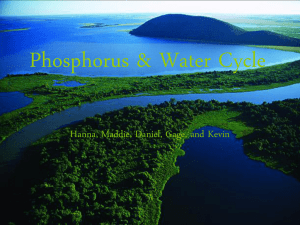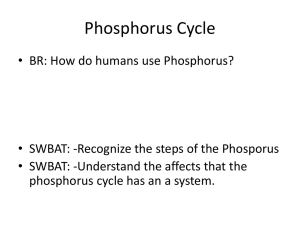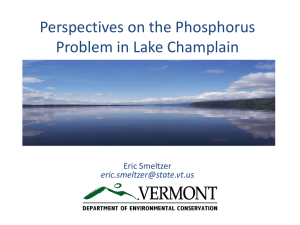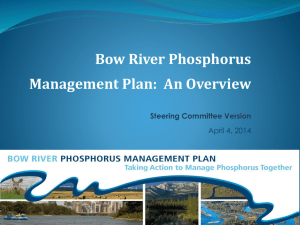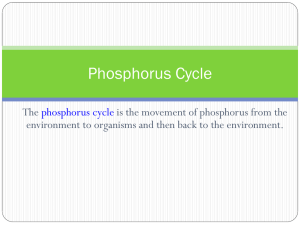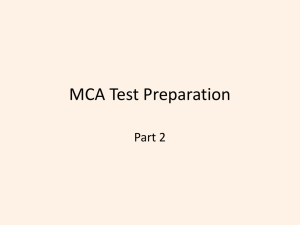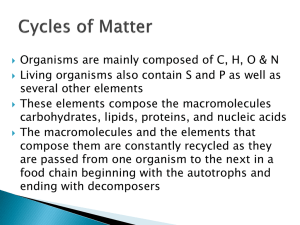David Baker, Heidelberg University
advertisement
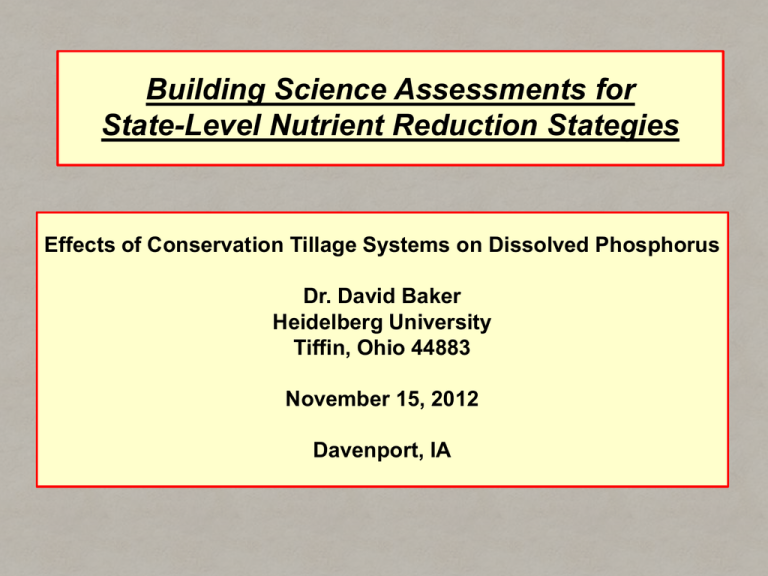
Building Science Assessments for State-Level Nutrient Reduction Stategies Effects of Conservation Tillage Systems on Dissolved Phosphorus Dr. David Baker Heidelberg University Tiffin, Ohio 44883 November 15, 2012 Davenport, IA This talk -Lessons learned from agricultural phosphorus control programs in the Lake Erie Basin The teacher has been: 1. Detailed, long-term monitoring data for several major watersheds draining into Lake Erie. 2. Information on changing crop production practices in those watersheds. This research was supported by state and federal agencies, foundations , agribusinesses and the fertilizer industry . Special thanks to the EPA’s Great Lakes National Program Office and the Great Lakes Protection Fund for recent support for bioavailability studies and phosphorus stratification studies. 15 stations All at USGS Stream Gages Today’s data from three rivers: Maumee – 6,330 sq.mile Sandusky – 1,250 sq. mile Cuyahoga - 708 sq. mile Analytical Program at the NCWQR 1. 2. 3. 4. 5. 6. 7. 8. 9. 10. 11. 12. Suspended solids Total phosphorus Dissolved reactive phosphorus Nitrate Nitrite Ammonia Total Kjeldahl Nitrogen Chloride Sulfate Silica Fluoride Conductivity Seasonally pesticides Selected metals Bioavailable Phosphorus Program Characteristics: • Program started in 1975 • ~ 500 samples analyzed per station per year • Annual loads calculated by integration with corrections for final USGS daily discharge • Data available at Heidelberg’s web site: http://www.heidelberg.edu /academiclife/distinctive/nc wqr/data Management Options for Phosphorus Load Reduction Focus of reduction programs Total Phosphorus Load Total Bioavailable Phosphorus Load = Total Particulate Phosphorus Load = Bioavailable Particulate Phosphorus Load + Total Dissolved Phosphorus Load + Bioavailable Dissolved Phosphorus Load Nonpoint phosphorus control programs were planned in the 1980s and initiated in the 1990s. Forms of phosphorus transported in northwestern Ohio rivers, 1975-1987. Dissolved Phosphorus 18% Particulate Phosphorus 82% Particulate phosphorus during storm runoff is attached to soil particles. Phosphorus reduction programs focused on reducing erosion and particulate phosphorus loading through fostering adoption of no-till and reduced till crop protection methods. 1. What does the water quality monitoring data look like? 2. What changes in agricultural practices could explain the loading changes? 3.What changes in hydrology could help explain the loading changes? Trends in annual loads and flow weighted mean concentrations of particulate phosphorus in the Maumee and Sandusky rivers • Note the close relationship between variations in annual discharge and variations in TP load. • Discharge increased by 41% while TP load increased by 31%. • Weather and hydrology drive nonpoint pollution from cropland. Trends in annual loads and flow weighted mean concentrations of dissolved reactive phosphorus in the Maumee and Sandusky rivers Dissolved Reactive Phosphorus 50% decrease from 1982-2011 Total Phosphorus 24% decrease from 1982-2011 From here To here Phosphorus reduction programs in the Lake Erie Basin have been driven by the lake’s eutrophication problems. Point source control problems were initiated first and quickly resulted in substantial reductions in phosphorus loading. How does nutrient export from the Northwestern Ohio rivers compare with the export from other areas? Total Phosphorus Tributary Loads to Lake Erie, 2005 Maumee Sandusky Cuyahoga Thames Cattaraugus Creek Grand (Ont) Chagrin Huron (OH) Vermilion Grand (OH) Black Detroit R Canada Maumee and Sandusky • 26% of land area • 51% of total phos. load • Export rate 3x higher than average for rest of drainage area Land use in study watersheds, as percent Watershed Maumee Sandusky Cuyahoga Agricul -ture Forest 73.3 77.6 9.0 6.5 8.8 33.6 Grass_ Open Hay_ Urban Wetland Other Water Pasture 6.3 0.7 10.6 2.3 0.2 4.3 0.5 8.1 0.3 0.3 11.8 2.6 39.5 3.1 0.4 Average annual nutrient export rates, 1996-2011 River Maumee Sandusky Cuyahoga DRP, DRP as % TP SS TP, lbs/acre lbs/acre lbs/acre 1.21 1.46 1.26 0.25 0.29 0.18 504 642 1,175 21% 20% 14% NitrateN TKN, lbs/acre lbs/acre 17.08 18.73 7.59 5.23 5.76 4.86 Data for 2004-2008 Water Years Watershed Point source Non-Point Phosphorus Phosphorus Maumee 5% 95% Sandusky 3% 97% Trends in tillage practices in northwestern Ohio: 1989-2004 Tillage Practices in the Sandusky Watershed: 2009-2010 Tillage Practices Corn, (1142 fields) Soybeans (1147 fields) Wheat (945 fields) Hay (52 fields) 5% 1% 1% 4% 1 Moldboard plow, < 5% cover 2 Reduced tillage, soil heavily mixed, < 30% cover 72% 9% 3% 48% 3 Mulch tillage, soil lightly mixed, > 30% cover 15% 17% 12% 13% 4 No till, strip till 8% 73% 84% 35% “Rotational no till” Phosphorus fertilizer sales in Ohio, 1955-2007 Heidelberg Monitoring started Long-term trend in average phosphorus soil tests in Northwest Ohio Start of Heidelberg monitoring How will the majority of phosphorus fertilizer be applied to this field? Fertilizer application method # of fields % of fields 1 Broadcast and unincorporated 211 20% 2 Broadcast and incorporated within one week 212 21% 3 Broadcast and incorporated after one week or more 115 11% 4 Banded with corn planter 496 46% 5 Banded more than 2 inches deep with a coulter/knife injection tool 23 2% Total number of reported fields Sandusky Watershed Soil Stratification Studies 1,030 100% When will the majority of phosphorus fertilizer be applied? Timing of fertilizer application # of fields % of fields 86 8.4 % 513 50.0 % 92 9.0 % In fall (September – November) after soybean harvest 283 27.6 % 5 In fall, (September – November) after corn harvest 47 4.6 % 6 In winter (December – March) 4 0.4% 7 In winter (December – March) on snow covered or frozen soils. 1 0.1 % 1 In spring (April to June), prior to planting 2 In spring (April to June), at planting 3 In late summer or fall (August – November) after wheat or hay harvest. 4 Total Responses 1,026 Total Phosphorus Loading Total Bioavailable Phosphorus Loading A bottom line … 1. After 20+ years of efforts to reduce phosphorus loading to Lake Erie from cropland, we now have more bioavailable phosphorus entering Lake Erie from cropland than ever. 2. The increases in bioavailable phosphorus loading are due to increases in dissolved phosphorus runoff. 3. The increases in dissolved phosphorus loading appear to be contributing increased harmful algal blooms in Lake Erie. Characteristics of average annual export of phosphorus from the Sandusky River, 2002-2011 Total Phosphorus (594 metric tons/year) 73% particulate phosphorus 27% dissolved phosphorus 93% bioavailable 29% bioavailable Management choice impacts-• Trading • TMDLs • BMP selection Bioavailable Phosphorus (275 metric tons/year) 46% particulate phosphorus 54% dissolved phosphorus Why has the dissolved phosphorus loading from the Sandusky and Maumee rivers dropped and then increased so much? Potential causes of the increasing dissolved phosphorus export 1. increasing fall and winter broadcasting of phosphorus fertilizers, often without timely incorporation. 2. phosphorus stratification in the soil associated with widespread adoption of no-till and reduced-till production and the accompanying lack of inversion tillage. 3. increased tile drainage coupled with macropore flow that carries surface water to tile drains and increases total discharge. 4. increasing trends in flashiness of northwestern Ohio streams. 5. changes in rainfall patterns that have resulted in increases in winter rainstorms and resulting stream flows, especially in December and January. Phosphorus stratification in cropland of the Sandusky Watershed Analysis of dilute aqueous soil suspensions Analysis of dilute aqueous soil suspensions Questions? NCWQR Phosphorus Analyses Bioavailable Forms Portion Analyzed Total Phosphorus (TP) whole sample Dissolved Phosphorus (DP) Sample Pretreatment acid added oxidant added autoclave x x x (filter sample through 0.45 micron filter) Dissolved Reactive P (DRP) filtrate --- --- --- Dissolved Hydrolyzable P (DHP) filtrate x --- x Total Dissolved P (TDP) filtrate x x x Dissolved Organic P (DOP) Particulate Phosphorus (PP) NaOH Extractable PP all samples calculated as TDP - DHP calculated as TP - TDP (extract residue on filter with NaOH and analyze as DRP) extra analyses for bioavailability studies

